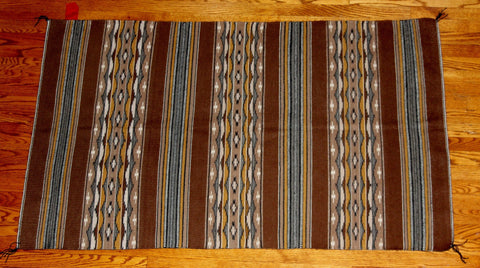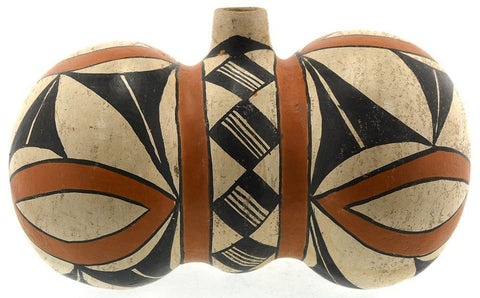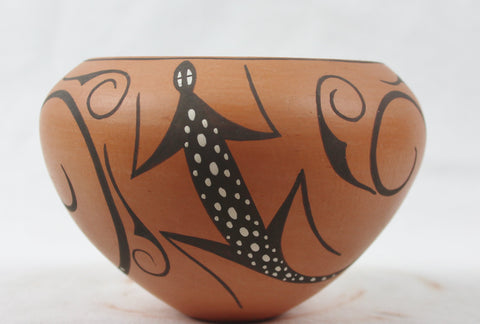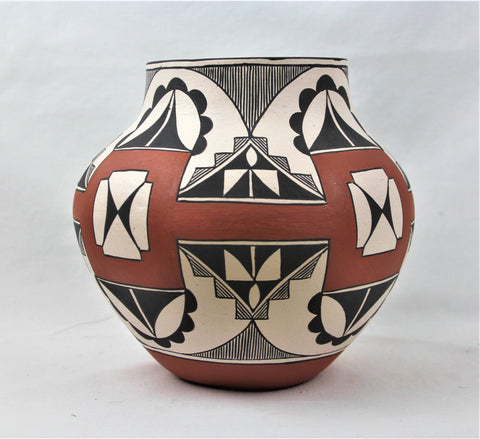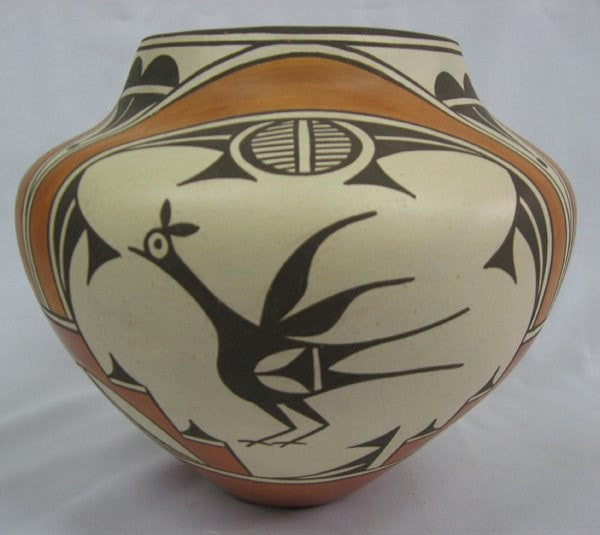
Native American Zia Pueblo Pottery : 1950's Zia Pueblo Bird Polychrome Olla by Sofia Medina #249 Sold
$ 2,880.00
Native American
Zia Pueblo Pottery
249. Description: Native American, Zia pueblo pottery. From the Southwestern Americana Collection Scottsdale AZ, Estate. A 1950's Zia Pueblo Bird Olla by Sofia Medina (1932-2010), measures 10''H x 12''D, features 3 Zia Birds amidst traditional geometric and abstract designs, heavy walled, designed in 3 quadrants featuring 3 Zia birds around bowl, signed by artist on side of olla ''Sofia Medina Zia'', Artist Bio: Sofia Medina (1932-2010) ''When Sofia Medina passed on in 2010, she left behind half a century of recognition as Zia's leading potter and the further honor of a Lifetime Achievement Award at the 2009 Indian Market- the highest acclaim a Native American artist can achieve.'' Excellent condition.
"Sofia Medina and Lois Medina are a mother and daughter team which with combined efforts produce some of the finest Zia Pueblo pottery around today. Sofia was born in 1932 and Lois was born in 1959. Sofia has been making pottery since 1963.
Trinidad Medina, who was a prolific and one of Zia‰۪s finest potter‰۪s, taught her all the fundamentals of making traditional Zia pottery and encouraged her to continue the long lived family tradition of hand coiling pottery.
Sofia and Lois specialize in making hand coiled Zia pottery just like their ancestors before them. All the materials used on their pottery come from within the Zia Pueblo. The clay is gathered from the grounds within the pueblo. They clean, mix, hand coil, shape, paint, and fire the pottery the traditional way, outdoors. The colors are derived from natural plant life and minerals also found within the Zia Pueblo.
They both contribute equally while constructing their pottery. Trinidad encouraged Sofia to teach each and every one of her children the art of hand coiling traditional Zia pottery, so they may be able to contribute to the legacy which is bestowed upon them as well.
Sofia & Lois said, Spiritually, making pottery eases your mind, and we sing and pray while making our pottery.They sign their pottery as: Sofia Medina-Lois Medina, Zia. They are related to Marcellus Medina and Herman Medina (sons/brothers).
Awards:
-Santa Fe Indian Market
-New Mexico State Fair
-Eighth Northern Arts & Crafts Show
Collections:
-Albuquerque International Airport
-Smithsonian in Washington, D.C.
Publications:
-Southern Pueblo Pottery 2,000 Artist Biographies
-Fourteen Families in Pueblo Pottery
-Southwestern Pottery Anasazi to Zuni
-Talking with the Clay" (Source: Ancientnations.com)
A History of Pueblo Pottery:
“Pueblo pottery is made using a coiled technique that came into northern Arizona and New Mexico from the south, some 1500 years ago. In the four-corners region of the US, nineteen pueblos and villages have historically produced pottery. Although each of these pueblos use similar traditional methods of coiling, shaping, finishing and firing, the pottery from each is distinctive.
Various clay's gathered from each pueblo’s local sources produce pottery colors that range from buff to earthy yellows, oranges, and reds, as well as black. Fired pots are sometimes left plain and other times decorated—most frequently with paint and occasionally with appliqué. Painted designs vary from pueblo to pueblo, yet share an ancient iconography based on abstract representations of clouds, rain, feathers, birds, plants, animals and other natural world features.
Tempering materials and paints, also from natural sources, contribute further to the distinctiveness of each pueblo’s pottery. Some paints are derived from plants, others from minerals. Before firing, potters in some pueblos apply a light colored slip to their pottery, which creates a bright background for painted designs or simply a lighter color plain ware vessel. Designs are painted on before firing, traditionally with a brush fashioned from yucca fiber.
Different combinations of paint color, clay color, and slips are characteristic of different pueblos. Among them are black on cream, black on buff, black on red, dark brown and dark red on white (as found in Zuni pottery), matte red on red, and polychrome—a number of natural colors on one vessel (most typically associated with Hopi). Pueblo potters also produce undecorated polished black ware, black on black ware, and carved red and carved black wares.
Making pueblo pottery is a time-consuming effort that includes gathering and preparing the clay, building and shaping the coiled pot, gathering plants to make the colored dyes, constructing yucca brushes, and, often, making a clay slip. While some Pueblo artists fire in kilns, most still fire in the traditional way in an outside fire pit, covering their vessels with large potsherds and dried sheep dung. Pottery is left to bake for many hours, producing a high-fired result.
Today, Pueblo potters continue to honor this centuries-old tradition of hand-coiled pottery production, yet value the need for contemporary artistic expression as well. They continue to improve their style, methods and designs, often combining traditional and contemporary techniques to create striking new works of art.” (Source: Museum of Northern Arizona)
----------
View the other items in my shop: http://www.etsy.com/shop/CulturalPatina?ref=shopsection_shophome_leftnav

